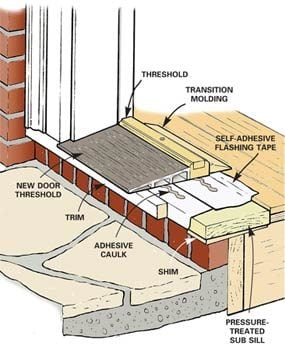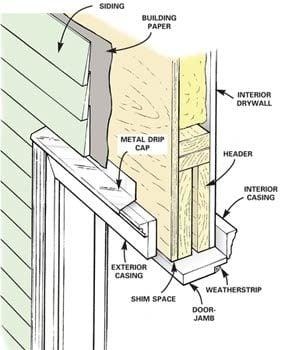How to Replace an Exterior Door
Updated: Mar. 01, 2023
DIY techniques for a weathertight exterior door installation
Multiple Days
Intermediate
Varies
Introduction
Replace a worn, drafty front door with a stylish new energy-efficient one. Replacement doors come pre-hung in a weatherstripped frame and you don't have to be a master carpenter to do a first-class job. We'll show you the techniques that will result in a perfect, weathertight installation.Tools Required
- 2-ft. and 4-ft. levels
- Caulk gun
- Hammer
- Miter saw
- Nail set
- Pry bar
- Reciprocating saw
- Tape measure
- Utility knife
Materials Required
- 10d finish nails
- 10d galvanized casing nails
- 16d galvanized casing nails
- 3-in. deck screws
- 4d finish nails
- 6d finish nails
- Backer rod
- Minimal expanding foam
- Polyurethane caulk
- Roll of flexible self-sticking flashing membrane
- Transition molding Transition molding (optional; Photo 13)
- Treated lumber to build up the sill (optional)
Prehung Exterior Door Installation

Rarely can you complete a project in a weekend that will save you money and dramatically improve the looks of your house like hanging a new front door. In this article we’ll show you how to order a prehung exterior door that fits like a glove. Then we’ll show you, step by step, how to get your old door out and the new one in.
If you can handle basic carpentry tasks, you’ll have no trouble installing a new pre-hung entry door in a day. Figure on another day to finish the details and start painting the door. Front door paint adds personality and curb appeal.
Video: How to Hang a Door
Project step-by-step (19)
Figure A: Measure Your Old Door
In most cases, simply order a new door the same size as the old one. If you alter the size or add sidelights, you’ll have to reframe the opening and alter many details. This usually doubles or triples the size of the job. Here are the four sets of measurements you’ll need to order a door (refer to Figure A for extra details):
Door size
- Measure the width and height of your old door.
- Round these up to full inches to find the size of the replacement door you’ll need.
- For example, if your door measures 35-3/4 in. wide and 79-1/2 in. tall, you’ll order a 36-in. by 80-in. door.
Jamb width
- Measure from the backside of the interior trim to the backside of the exterior trim (Figure A).
- Specify this jamb width when you order your new prehung door.
- This guarantees that the interior trim will fit flush to the wall without adding “jamb extensions.”
Rough opening
- You’ll need to remove the interior trim for accurate measurements of the rough opening.
- Measure the opening width between framing members and from the bottom of the sill to the top of the opening.
- Compare these measurements to the rough opening requirements of your new door to make sure it will fit.
Exterior opening (or “masonry opening” if you have a brick or stone door surround)
- Measure to the outsides of the exterior casing, then from the bottom of the sill to the top of the trim.
- Compare these measurements with those of a prehung door that has standard two-inch-wide “brick molding” trim.
- If the framed door with standard trim is too small to fill the space, or if you want a different trim style, you have three options.
- The best solution is a door with wider, flat casing to fit the opening. You can always add a piece of decorative molding overtop to approximate the style of your existing exterior trim. (We ordered 2-1/4-in. flat casing and reinstalled the existing decorative molding.)
- Second, you can order your door with standard molding and fill the gap with additional strips of wood.
- The last option is to order the door without exterior molding and make your own to fit.
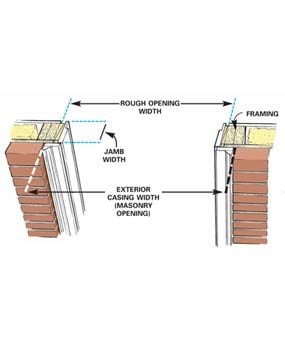
Remove Your Old Door
- Tap the hinge pins loose with a hammer and nail set.
- Then swing the door open and lift it off.
- Protect the floor with a dropcloth. The old door will be heavy.

Pry Loose The Old Trim
- Pry the interior trim loose from the door frame.
- Protect the wall with a wide putty knife.
- If you plan to reuse the trim, first score the intersection between the molding and jamb with a utility knife.
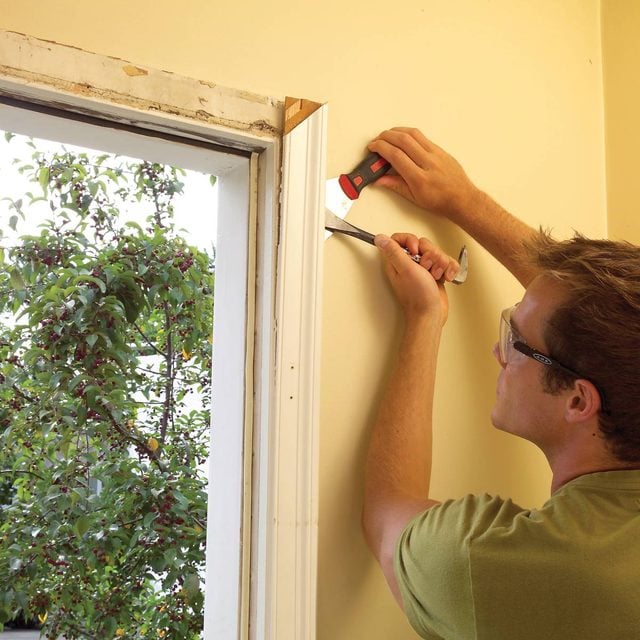
Pry Off the Exterior Trim
- Slice the caulk joint between the siding (brick) and exterior trim.
- Pry the trim from the doorjamb with a pry bar.
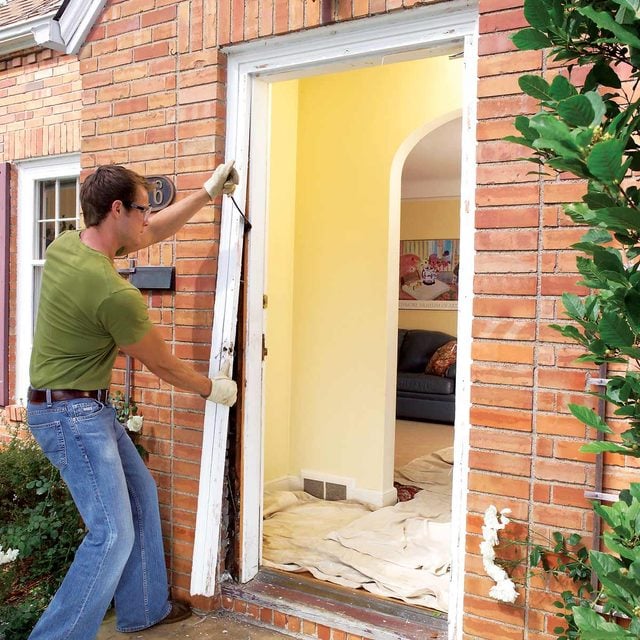
Remove the Jambs
- Cut completely through the side jamb with a handsaw.
- Pry the jambs loose and pull them out of the opening.

Jamb Removal Close-Up
- If you plan to reuse the interior moldings, pull the nails through the backside with a pliers or nipper to avoid damaging the face.
- Cutting through one side jamb makes it easy to tear out the entire frame.
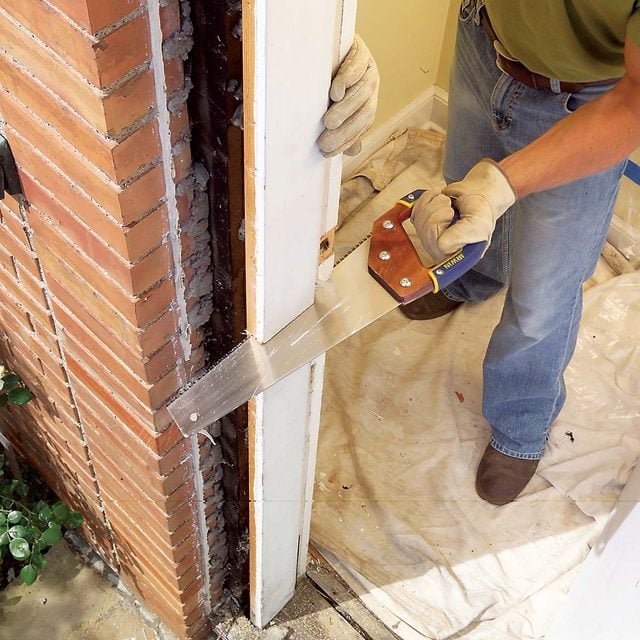
Prepare and Install the Sill
- After the door frame is out, check the condition of the framing and subflooring in the sill area.
- Cut out and replace any rotted wood.
- If the sill on your new door is thinner than the one you removed, you may have to build up the sill area. We were lucky. Our brick opening was level and plumb, but this isn’t always the case.
- Start by checking the sill area with a two-foot level. If you’re building it up as we show in the photo below, it’s easy to level it with shims at the same time.
- Set the sill height so the door just clears carpeting or rugs when it swings inward.
- Build up the sill area to the proper height with treated lumber. Add shims to level it.
- Level the sill area with pairs of shims spaced about four inches apart.
- Then set the door in the opening for a test fit. Hold a level against the hinge jamb and adjust the door and frame until the jamb is plumb.
- Check to see how the casing fits against the siding. If the siding is so far out of plumb that the door frame and casing don’t fit in, either cut back the siding or trim the casing. It looks better if you can cut the siding, but it’s usually more practical and easier to trim the casing.
- Mark the casing in areas that need trimming.
- Then take the door out and trim the casing with a belt sander or circular saw.
- Once level, fasten it with coated deck screws.
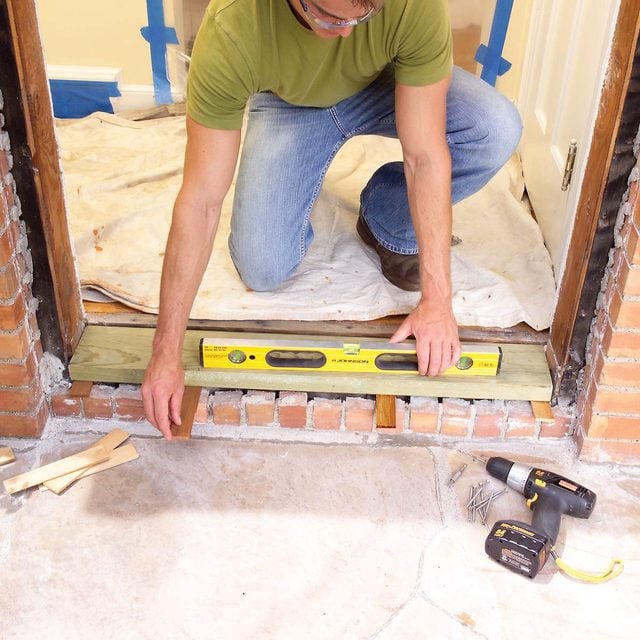
Install Flashing Tape
- Installing flashing tape will protect the sill from water intrusion. Buy the flashing tape from lumberyards.
- If you’re installing a door in a newly constructed wall, you can buy a special plastic sill flashing kit instead. One brand is Jamsil. Details will vary depending on the doorway situation.
- Cover the rough sill area with self-sticking flashing tape.
- Wrap it up the sides of the opening and over the front edge.
- Set the door in the opening, plumb it and check the fit.
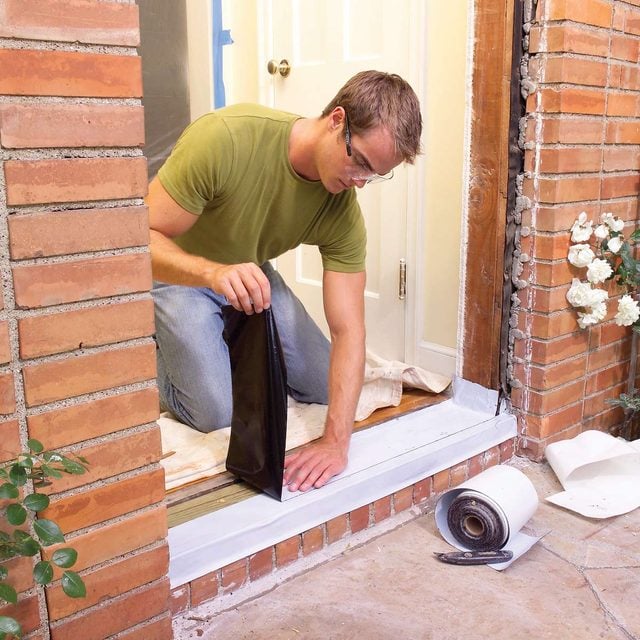
Figure B: Sill Detail
- The idea is to channel water away from the wood. If your home is built on a concrete slab, the door frame will probably rest directly on the slab.
- Figure B illustrates how to correctly install your sill to reduce any future potential of water damage.
Apply Caulk
- Make sure the building paper is intact around the frame edges. If not, slide strips of No. 15 felt behind the siding and tack it to the framing with staples.
- When you’re sure the door will fit, caulk along the sill and behind the casing and tip the door into the opening.
- Apply a bead of polyurethane caulk along the sides and top of the door opening and at the sill according to the manufacturer’s instructions.
- You’ll likely need two tubes.

Tack in the Prehung Exterior Door
- Make sure the doorsill is level.
- Then center the top of the door in the opening and tack it into place with galvanized casing nails.
- Plumb the hinge-side jamb and tack the bottom corners.

Shim the Hinge-Side Jamb
- Shim behind each hinge.
- For large spaces, start with small squares of plywood.
- Then finish with pairs of shims.
- Make sure the hinge-side jamb remains plumb.
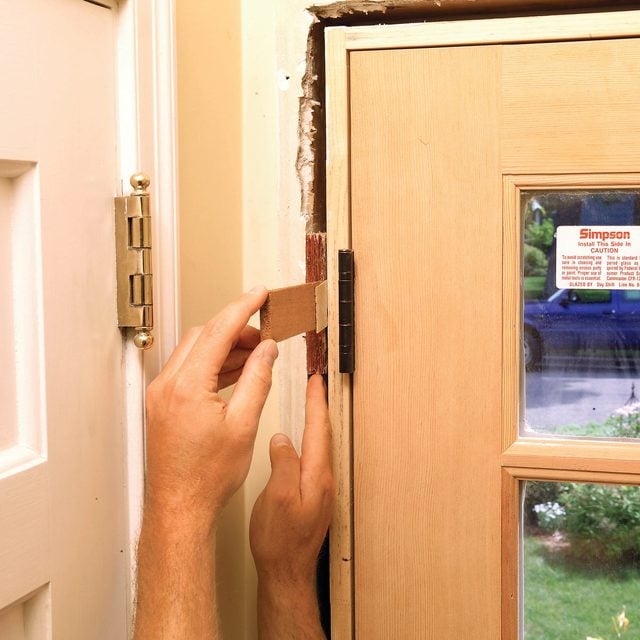
Shim the Latch-Side Jamb
- The goal is to center the door in the opening and shim the sides until they’re plumb and straight.
- Shim at the top, middle and bottom of the latch-side jamb and at the top until the gap between the door and the doorjamb is consistent.
- Score the shims with a utility knife and break them off.
- When you’re happy with the fit, nail through the jamb into the framing at each shim location.
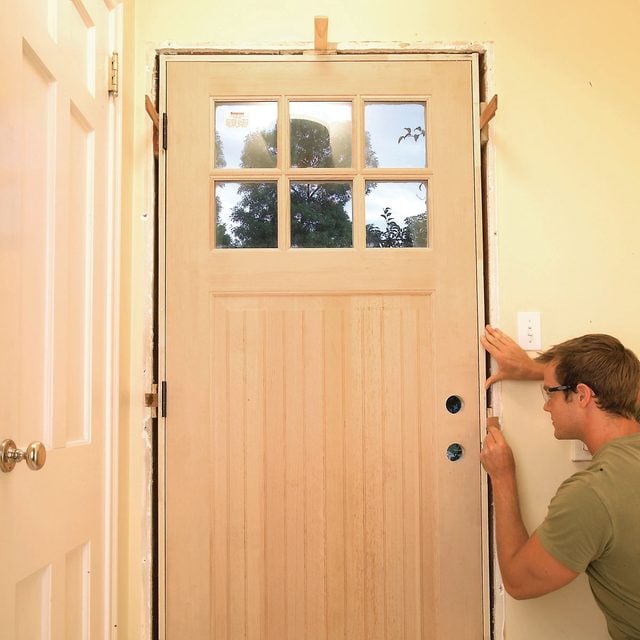
Replace the Hinge Screws
- Replace a screw in each hinge with a three-inch screw driven into the framing.
- Drive additional casing nails every 16 in. along the sides and top of the exterior trim.

Figure C: Drip Cap
- If your door is exposed to the weather, direct water away from the door with a metal drip cap overtop as shown in Figure C. You’ll find drip caps at home centers and lumber yards.
- Brick openings like ours and doors protected by porches with roofs don’t require a drip cap.
- If the drip cap is damaged or missing, install a new one before you set the door frame in the opening.
- Cut the metal drip cap to fit and slide it under the siding and building paper (Figure C).
- If nails are in the way, slip a hacksaw blade under the siding and cut them.
Insulate Around the Door
- Fill the space between the doorjamb and the framing with minimal expanding foam insulation (you’ll need about two cans).
- After the foam has expanded and skinned over, loosely stuff any remaining space with strips of fiberglass insulation.
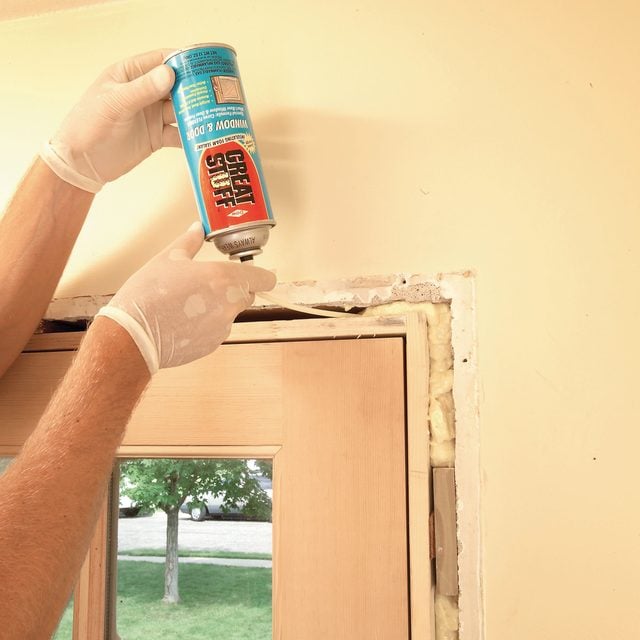
Install Interior Trim
- Cut and install new interior trim or reinstall the old trim.
- If there’s a gap between the new sill and the existing flooring, cover it with a beveled transition.
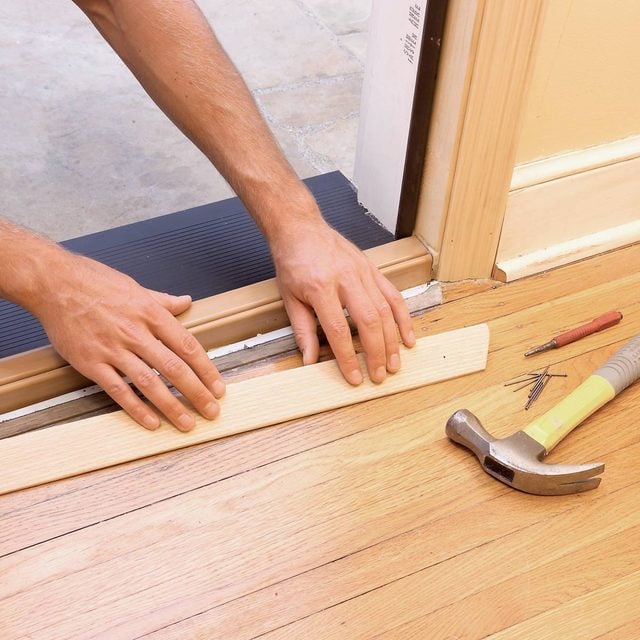
Apply Caulk Backer and Caulk
- Press foam backer rod into the siding/trim gap.
- Apply a neat bead of caulk between the siding and the door trim.
- Cut a trim board to fit under the sill and screw it to the framing.
- For gaps wider than 3/16 in., insert a foam backer and apply caulk over it.
- Most doors require an additional trim board under the sill to support its outer edge.
- Finally, remove the door and paint or stain and varnish the door, jamb and trim.
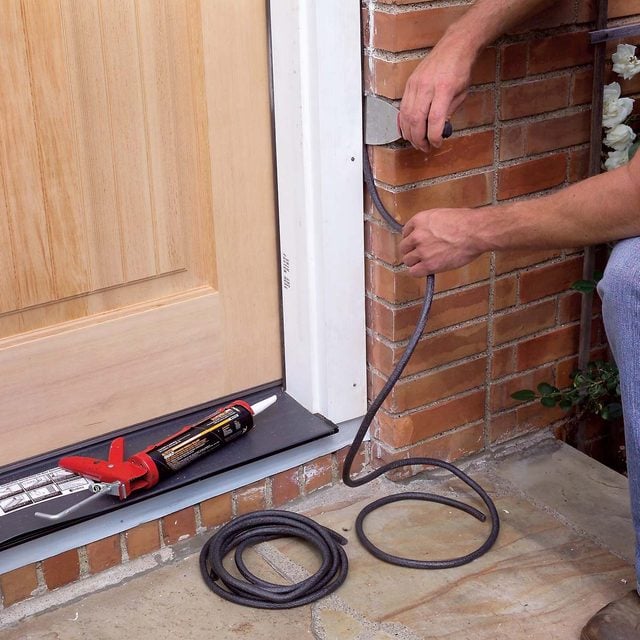
Editor’s Note: Buying a New Prehung Exterior Door
Most home centers stock prehung exterior doors in a limited number of styles.
- Common jamb widths for stock doors are 4-9/16 in. and 6-9/16 in., and they usually include two-inch wide brick molding for exterior trim. These doors work great for newly constructed walls and for replacing doors in newer homes.
- But if, after measuring the jamb width and opening sizes for your existing door, you discover that you need a different size jamb or that your exterior trim is wider, then you’ll save a lot of headaches by ordering a door to your exact specifications.
There are three types of doors to choose from.
- Steel doors are popular because they’re inexpensive and require little maintenance.
- Fiberglass doors won’t warp or rot, and the more expensive models are hard to tell apart from real wood.
- You’ll find the widest selection of styles in wood doors, but be prepared to spend extra time maintaining the finish.
Prehung exterior doors are available at home centers and lumberyards. If you can’t find what you’re looking for in stock, you can order it.
- Take along your measurements and a sketch showing which way the door swings.
- If you plan to install a new entry knob and deadbolt, pick them out before you order the door.
- Then ask the salesperson to have the door drilled to accept your hardware. It’ll cost a little extra, but it’s well worth it to avoid the nerve-racking job of drilling into a new door.
- Don’t forget to order hinges that will match the finish of your hardware.
Get some ideas for a new door after looking at this stunning door options.


